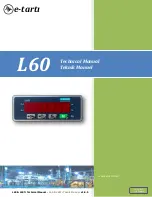
6.0 OPERATION
•
The basic weighing functions are same for both the scales- local and
remote. However the number of weighing divisions may be less on the
remote scale dependant on the total capacity of the load cell/s used.
•
Each scale (local or remote) has the ability to count parts based on the
current unit weight. This is best obtained by performing a sample on the
local scale which may have the best sensitivity. Then the scale can be
switched to the remote where large quantities can be counted.
•
Each scale has a separate tare value that can be entered through the
keypad or by placing a weight on the platform and pressing the
[Tare/Zero]
key. The tare value for each scale is retained as the user
switches between the remote and local scales.
•
Either scale can be used to determine a unit weight.
•
When the scale is switched from local to remote, a clear display will be
shown to identify the change and the scales will count based on the tare
and unit weight currently in use for the scale selected. Display for the
change is:
“
c h A n g E
” ”
L o c A L
“
and
“
c h A n g E
” ”
r e m o t E
“
The display will be based on the 7 segment interpretations, some of letters
are shown later.
•
The switch from local scale to remote scale should be possible at any time
by pressing the
[Local/Rem]
key or if the user enables the function it can
happen anytime the weight on the remote scale changes from negative
value or zero to a positive value greater than 50d.
NOTE:
For frequently used items, counting is made easier by using PLU
numbers (Product Look Up). Up to 100 PLU’s can be stored and recalled. See
section 6.4 on PLU for details. Place the item on the pan and enter using the
keypad “
PLUxx
” (where
xx
is the PLU number associated with that item). The
scale will display the Total Weight, Unit weight and the Count of the item in the
respective windows.
© Adam Equipment Company 2005
11













































